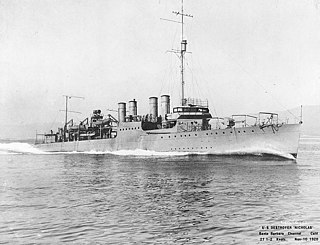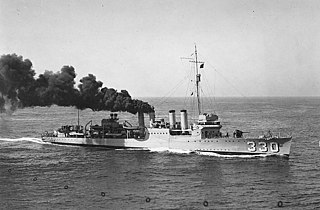
USS Thompson (DD-305), a Clemson-class destroyer of the U.S. Navy named in honor of Secretary of the Navy Richard W. Thompson (1809–1900), never saw action against an enemy. She was the first Navy ship of that name; the second, Thompson (DD-627), named for Robert M. Thompson, served during World War II and the Korean War.

USS Somers (DD-301), a Clemson-class destroyer, engaged in peacetime operations with the Pacific Fleet from 1920 until she was scrapped under the London Naval Treaty in 1930. She was the fourth ship of the United States Navy named for Richard Somers.

The Honda Point disaster was the largest peacetime loss of U.S. Navy ships. On the evening of September 8, 1923, seven destroyers, while traveling at 20 knots (37 km/h), ran aground at Honda Point, a few miles from the northern side of the Santa Barbara Channel off Point Arguello on the Gaviota Coast in Santa Barbara County, California. Two other ships grounded, but were able to maneuver free off the rocks. Twenty-three sailors died in the disaster.

The first USS Philip (DD–76) was a Wickes-class destroyer in the United States Navy during World War I, later transferred to the Royal Navy as HMS Lancaster. She was named for John Woodward Philip.

USS Hatfield (DD-231/AG-84) was a Clemson-class destroyer in the United States Navy during World War II. She was named for John Hatfield, killed in action 1813. As of 2021, no other ship of the U.S. Navy has been named Hatfield.

USS Fox (DD-234/AG-85) was a Clemson-class destroyer in the United States Navy during World War II. She was the fourth ship named for Gustavus Vasa Fox, Assistant Secretary of the Navy during the Civil War.

The fourth USS Lawrence (DD-250) was a Clemson-class destroyer in the United States Navy during World War II. She was named for James Lawrence.

USS Delphy (DD-261) was a Clemson-class destroyer in the United States Navy following World War I. It was the flagship of the destroyer group involved in the Honda Point Disaster.

The first USS Meade (DD-274) was a Clemson-class destroyer in the United States Navy and transferred to the Royal Navy as HMS Ramsey (G60).

USS Henshaw (DD-278) was a Clemson-class destroyer in the United States Navy following World War I. She was named for Secretary of the Navy David Henshaw.

USS John Francis Burns (DD-299) was a Clemson-class destroyer built for the United States Navy during World War I.

USS Stoddert (DD-302/AG-18) was a Clemson-class destroyer in the United States Navy following World War I. It was named for Benjamin Stoddert.

USS William Jones (DD-308), a Clemson-class destroyer in the United States Navy, named for William Jones.

The third USS Woodbury (DD-309) was a Clemson-class destroyer in the United States Navy. She was named for Levi Woodbury.

USS Nicholas (DD-311) was a Clemson-class destroyer in the United States Navy following World War I. She was the first Navy ship named for Samuel Nicholas (1744–1790), the first Commandant of the United States Marine Corps.

The first USS Young (DD-312) was a Clemson-class destroyer in the United States Navy following World War I. She was named for John Young.

The second USS Hull (DD-330) was a Clemson-class destroyer in the United States Navy following World War I. She was named for Isaac Hull.

USS Sicard (DD-346/DM-21/AG-100) was a Clemson-class destroyer in the United States Navy following World War I. She was named for Montgomery Sicard.

USS Willard Keith (DD-775), an Allen M. Sumner-class destroyer, is currently the only completed ship of the United States Navy ever named for Willard Keith, a United States Marine Corps captain who died in combat during the campaign for Guadalcanal. He was awarded the Navy Cross for his actions.

USS James C. Owens (DD-776), an Allen M. Sumner-class destroyer, is the only ship of the United States Navy FRAM II class to be named for Lieutenant James C. Owens Jr., a member of Torpedo Squadron 8 on board USS Hornet. His entire squadron was lost in an attack against Japanese aircraft carriers 4 June during the Battle of Midway. Lt. Owens received the Navy Cross and the Presidential Unit Citation (US) posthumously.




















